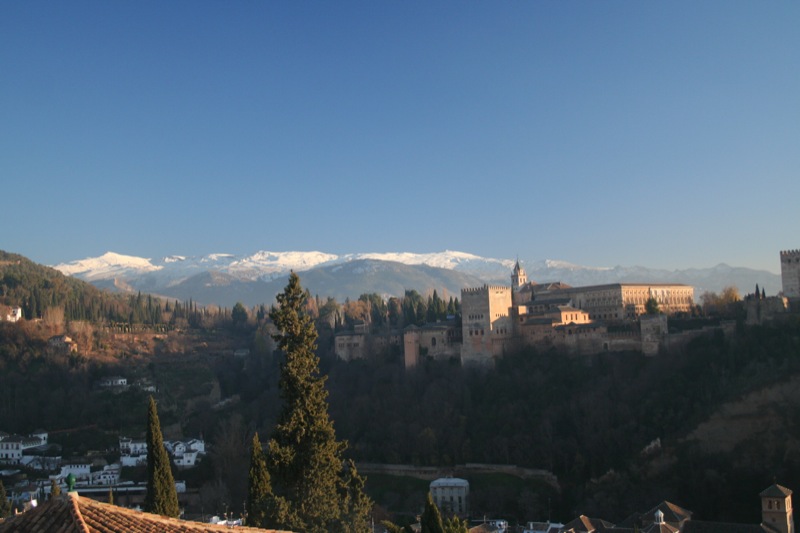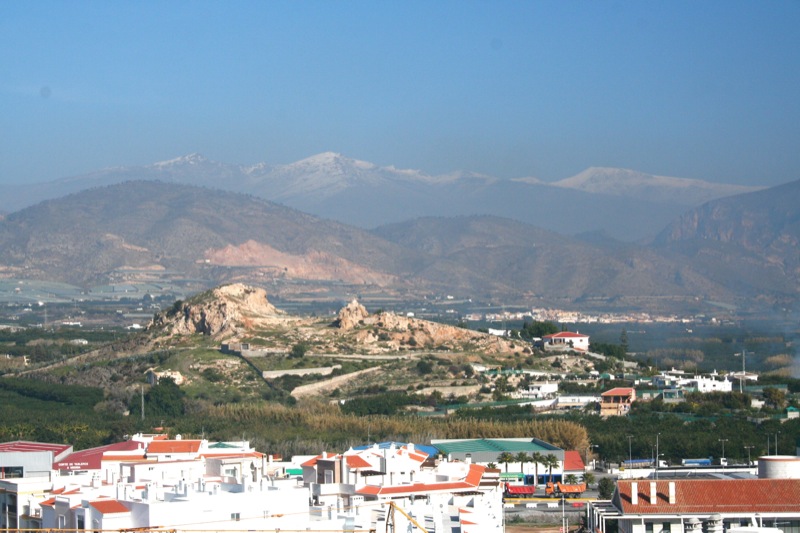Friday, 25 July 2008
Thursday, 24 July 2008
Chartres en lumières

Chartres Cathedral
Thu 24 Jul
Figures on one of the portals of the cathedral picked out in colour. The whole town is one great light-show - houses, churches, bridges.
Wednesday, 23 July 2008
Mulhacén and back 5: been there, done that
 Thu 19 / Fri 20 Jun
Thu 19 / Fri 20 JunCapileira, Sierra Nevada
That evening in Capileira I had a delicious lamb cous-cous at the wonderful little Ibero restaurant. It was a bit of a struggle climbing back up through the village to the hostal afterwards, but hey, what’s 5 minutes when you’ve just walked up Mulhacén and back?
The following morning I picked up all the things the well-prepared mountain walker would have taken up with him in the first place - a detailed map, a guide book, a plant book - and a couple of collapsable sticks.
And then on the way out I stopped off in Pampaneira, at the Sierra Nevada Information Centre, where I got my final memento:
Cumbres de Sierra Nevada
Peaks of Sierra Nevada
En la montaña, por tu seguridad ¡déjate guiar!
In the mountains, for your own safety, go with a guide!
Other accounts
Jari Kirvesoja
Mulhacén and back: background - ascent - at the top - descent - been there, done that
Bloglets: full moon - single file - pause - at the top - back in Salobreña
Bloglets: full moon - single file - pause - at the top - back in Salobreña
Mulhacén and back 4: descent
 Thu 19 Jun
Thu 19 JunMulhacén, Sierra Nevada
Descent: album
Coming down was harder than going up, largely because by that time my legs already had the going up in them. Fernando took us down via the incredibly steep Loma del Mulhacén. I hobbled down the first bit, doing my best to concentrate on admiring the view.
Admiring the view
However halfway down my legs gave up completely, stiff with cramp. Everyone gathered round and I was offered all sorts of physical treatment from stretching, which helped but not enough, to massage, which was tempting and which perhaps I should have accepted.
Fernando gave me some salt tablets, which I think was the key; you are conscious of being thirsty and needing to take on water, but you don’t realise how much you are perspiring, and as the sweat evaporates, with it of course goes your body’s salt supply.
One of the Explorers kindly lent me one of her walking sticks - she insisted she didn’t need two, though I was sure she had been using both of them on the way down. The stick was a tremendous help on the rest of the steep descent, enabling me to get to the bottom of the slope without cramping up again (well, almost).
Part way down we paused to look at the North Face from below, at close quarters. Most impressive. Surely people don’t climb that for fun?
North Face of Mulhacén
Below it is a small lake, La Laguna de la Mosca (Lagoon of the Fly), which I imagine feeds one or other of the rivers that flow through the city of Granada.
Laguna de la Mosca
Strange to think that, on this northern side, the snow melt we were looking down on would eventually make its way across southern Spain - via the river Guadalquivir - to drain into the Atlantic, whilst the little lagoons we were heading down towards on the southern slope were making a beeline for the Mediterranean.
Southern lagoons
Once we got down to the lagoons we were on a track that more or less followed the contours back to the bus, and my legs began to feel as though they belonged to me again.
I am eternally grateful to Nevadensis - especially Fernando - for enabling me to do this walk, and to the people on the Explore trip and their guide Conal for accepting me into their group for the day, and helping me get through it. I’ve been wanting to do it for over 40 years, and if I were to leave it for another two or three years I probably wouldn’t be able to make it at all.
Although I do have some unfinished business up there - there’s all those flowers I didn’t manage to snap, and that final top rock I didn’t get up to . . .
Mulhacén and back: background - ascent - at the top - descent - been there, done that
Bloglets: full moon - single file - pause - at the top - back in Salobreña
Bloglets: full moon - single file - pause - at the top - back in Salobreña
Mulhacén and back 3: at the top
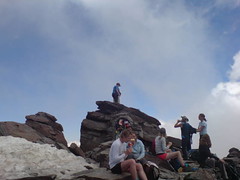
Thu 19 Jun
Mulhacén, Sierra Nevada
At the top: album
By the time I got to the top - ¡olé! - my legs were reluctant to do things you normally take for granted, like move, or support my weight. So I sat down and tried to massage and flex my muscles, and take in the view, and the achievement. And had half my cheese bocadillo, and half my water.
The views from the top are truly breathtaking, and different in each direction. The North Face is a sheer cliff, which funnels into a shallow glacial cirque, with a steep-sided V-shaped valley heading off to the north-west towards Granada and its Vega.
Looking down on Granada
This cliff curves round to the west, where it gives way to a long narrow ridge leading to the Veleta peak.
Towards Veleta
To the east there is a succession of rounded peaks separated by the major Alpujarra valleys, and to the south a much gentler incline leads back down to the Upper Poqueira Valley - this is the route we had come up by.
Towards the Alpujarra
I would have loved to have joined those who climbed up the last rocks, to get to the highest point, but there is no way I could have got up there. So I contented myself with taking a few photos, and sending one or two from my mobile phone to Flickr and to this blog; there is 100% coverage at the top, and most of the way up, which is reassuring.
Mulhacén and back: background - ascent - at the top - descent - been there, done that
Bloglets: full moon - single file - pause - at the top - back in Salobreña
Mulhacén and back 2: ascent
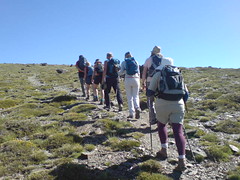
Thu 19 Jun
Mulhacén, Sierra Nevada
Ascent: album
As the bus wound its way up, Salobreña was visible from time to time, 60km away, a white speck on the coast. This did not surprise me all that much, as I figured that, since you can see Mulhacén from my house, you ought to be able to see my house - or at least, my town - from Mulhacén. Up until around 2000m, the road passed through high meadowland and wooded slopes, with occasional clusters of flowers creating teasing spots of colour that set my shutter finger twitching. Fernando, the guide, pointed out what he claimed were the highest bee-hives in Europe ... well, as he said, why not?
We got out at Alto del Chorrillo, and walked across to look almost vertically down the gorge over Trevélez, the village that claims to be the highest in Spain - well, why not? - and which is the home of some of the finest Iberian ham. A mouthwatering start to the day.
Trevélez, from Alto del Chorrillo
As we started walking up the views were ever-varied, and breathtaking. As I usually do, I paused from time to time to take photos - a mountain vista here, a tiny flower there.
Gentian and Saxifrage, peeking out
However I soon had to ration my stops, as I found the main body of the group quickly moving off into the distance; these were experienced walkers, and mostly a good deal younger than me, and I needed to keep going.
I soon found that talking while you walked was not an option, either; I had only flown in from the UK the day before, and the air that felt fresh and invigorating was, at approaching 3000m, considerably thinner than I was accustomed to.
Every now and then Fernando stopped to point out a view, or a rock formation, or a plant, or a bird. After an hour we stopped for a few minutes, for a drink and a brief rest, and an hour or so later Fernando decreed a food break.
Refuelling
Above 3000m I found myself struggling to keep up. I was beginning to lose touch with the rest of the group, and now and then losing track of the path; although the way is marked with little cairns, the mountainside is nothing but loose rock, and I sometimes found it difficult to distinguish the markers from the scree. Several times I found myself scrambling over the rocks until I came across the path again.
Where's the path?
Mulhacén and back: background - ascent - at the top - descent - been there, done that
Bloglets: full moon - single file - pause - at the top - back in Salobreña
Bloglets: full moon - single file - pause - at the top - back in Salobreña
Tuesday, 22 July 2008
Mulhacén and back 1: background
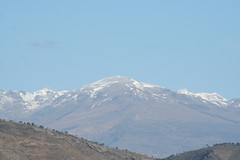
Thu 19 Jun
Mulhacén, Sierra Nevada
[If you see this account before I've managed to add in all the photo and other links, please come back a week or two later]
Mulhacén (3482m) is the highest peak of the Sierra Nevada, and the highest in continental Spain (Teide, in Tenerife, Canary Islands, is a bit higher).
Powered by Google Earth Hacks | Map Details | Create your own!
NB: If this doesn't display, you may need to download and install the Google Earth plug-in.
The Sierra Nevada (map, satellite photo) runs west-to-east across Andalucía, and its peaks are visible from well over 100km away on all sides. On the northern side, the major peaks provide a snow-topped backdrop to the city of Granada throughout much of the year
Backdrop to Granada
- whilst to the south they are also visible from many points along the coast.
Mulhacén from Salobreña
Twenty years ago you could drive your own car up to the top of nearby Veleta, and down the other side, although the higher roads were unsurfaced, and it wasn’t exactly encouraged. Nowadays, quite rightly, the whole area is a protected National Park, and private vehicles are not allowed in.
Veleta, from halfway up Mulhacén
There are several ways to get up Mulhacén: you can walk, you can walk, or you can walk, and if you're really daft you could try scaling the North Face.
Fancy scaling the North Face of Mulhacén?
Some do it as part of a longer trek across the Sierra Nevada, over two or more days, camping out or staying in unattended mountain refuges; most go up as I did on a one-day excursion from the southern side, taking a bus part-way up, to Alto del Chorrillo (2600m), some way into the National Park, and walking the rest.
Another possibility is to drive your own car up to the entrance to the National Park, and walk from there; this gives you several hours’ more walking to get up to the top and back, although you are not then tied to the bus timetable.
The buses run from the three Poqueira Valley villages (pic) - Pampaneira, Bubión and Capileira, which is the highest at 1400m. If you just want to take the bus to Alto del Chorrillo, as several people did the day I went, at 7.50€ return the fare compares well with travelling one stop on the London Tube.
The buses are run by Nevadensis, a tour company specialising in all types of Sierra Nevada trip. My excursion cost 40€, which covered the bus and the 6-hour guided walk. Their guides are superb: highly experienced, well-qualified, and very helpful. I had good cause to be thankful for this.
I stayed overnight in Capileira, at the comfortable and inexpensive Hostal Carril (aka Paco López, aka El Cascapeñas), and joined the bus at 8.30 the following morning.
The group I went up with were coming to the end of a 10-day walking holiday with the tour company Explore, and during the previous week they had already been up to one of the other high peaks as well as doing a number of other walks, including some that I had done on previous visits to the area, such as up the Poqueira Valley (pic), and round the Tahá villages (pic) - all highly recommended.
Mulhacén and back: background - ascent - at the top - descent - been there, done that
Bloglets: full moon - single file - pause - at the top - back in Salobreña
Bloglets: full moon - single file - pause - at the top - back in Salobreña
Tuesday, 15 July 2008
You didn't have to sing that song
Thu 10 Jul
Royal Oak, Lewes
In between Jim Causley's two sessions Vic managed to fit in half-a-dozen floor spots; there were so many there wanting to sing or play that they had to be limited to one piece each. Now most of them have repertoires in the scores or hundreds of songs - so how do they choose which one they're going to sing on any particular occasion? There must be all sorts of criteria at play in the mind of a singer when selecting what to sing: nice tune? nice words? good story? old song? new song? interesting harmonic structure? good chorus? makes people laugh? makes them cry? The reasons are very personal, and the list is potentially as long as the number of singers times the number of songs.
The approach to performance is also very personal. Some singers give lengthy introductions, others just stand - or sit - there and sing. Some prefer their audience to understand the context of their song, some want them to follow a story, others prefer to let the song do the talking. Almost always the singer wants their audience to get from the song something of what they, the singer, has put into it.
Sometimes the content of a song can be awkward. There may be sentiments expressed that not all listeners are comfortable with - sex, sexism, social attitudes, politics, death, to name but a few. At one point the other evening Jim Causley apologised for singing a song about a man who pushed his girl-friend in the river, with the excuse that he also sings one about a woman who metes out the same fate to her husband - though he wasn't going to sing it tonight. And we all laughed, or most of us did.
No-one laughed earlier, however, when one of the floor singers sang a version of Little Sir Hugh. In the song, Little Sir Hugh is playing at ball with his friends, the ball goes over a wall, a lady invites him to come in to collect it, and promptly lays him on a table and stabs him to death. So far, so traditional.
The Francis J Child collection of ballads has 20-odd versions of this song, which you can read through on the Sacred Texts website: Child Ballads 155: Sir Hugh, or the Jew’s Daughter. Most of these follow the original story, in which the ball goes into the garden of a Jew's house, the Jew's daughter entices him in with an apple plucked from her father's tree; his mother - Lady Mary - searches for him in vain, and the Jews try to get rid of the body but it keeps resurfacing and is eventually found in a drinking well.
At his burial “a’ the bells of merry Lincoln, without men’s hands were rung, and a’ the books o merry Lincoln, were read without man’s tongue.”
So many motifs in one song. And so much history hiding behind these powerful and seemingly innocent, traditional verses.
It’s a much sung and much recorded song. Steeleye Span recorded a version in 1975 - here, it's a castle wall and the murderer is a "lady gay" - Maddy Prior apparently did a clean-up job on it.
It was the original ‘Jew’s Daughter’ version that was sung last Thursday.
The story is in essence a medieval urban myth: the Jews sacrifice Christian children and use the blood in their rituals. It was one of several such myths used to great effect in stirring up racial and religious hatred throughout the Middle Ages and since, across wide areas of Europe.
In this case the song is based on events in Lincoln in 1255, which led to the trial and hanging of eighteen Jews for ritual murder. It was the first time that the English government had executed on this charge; the King had previously arrogated to himself the right to take over the property of any Jews convicted of crimes. The Spanish Inquisition weren’t the first in this field.
If you’re not familiar with the history, a good place to start is the account on Wikipedia: Little Saint Hugh of Lincoln, which has links to much else, including sections on the phenomenon of ‘Blood libel’, of which this incident, and the song which celebrates it, is a prime example. The fostering of these myths led to periodic massacres of Jews throughout Europe, right up to the Kielce pogrom in Poland in 1946.
And it didn’t just happen in the Middle Ages, nor only to the Jews. Greeks used the Blood Libel against Jews, Romans and Jews against early Christians, and it still surfaces across the world - the Wikipedia article mentions dozens of contemporary examples.
So what is the poor singer to do? Some singers don’t explain their songs, and some listeners don’t listen to them, or don’t follow the story at least. In any case, the old ballads often have convoluted and defective story-lines which wouldn’t make much sense even if you were to follow the words on paper as you listen.
Does it matter what the song says? Does a song ‘say’ anything?
What responsibility does a singer have when presenting a song to the public?
These are all questions which I’ve no doubt have been discussed to death elsewhere. All I would say here is that a singer is at least responsible for selecting what they are going to sing. And for at least attempting to understand what the song is about. And for the manner in which they present the song to the public. And that in this instance mumbling something about not sharing any anti-semitic sentiments in the song is absolutely insufficient, and totally irresponsible.
Unless you’re prepared to accept these responsibilities, the bottom line is:
You don’t have to sing those songs.
Royal Oak, Lewes
In between Jim Causley's two sessions Vic managed to fit in half-a-dozen floor spots; there were so many there wanting to sing or play that they had to be limited to one piece each. Now most of them have repertoires in the scores or hundreds of songs - so how do they choose which one they're going to sing on any particular occasion? There must be all sorts of criteria at play in the mind of a singer when selecting what to sing: nice tune? nice words? good story? old song? new song? interesting harmonic structure? good chorus? makes people laugh? makes them cry? The reasons are very personal, and the list is potentially as long as the number of singers times the number of songs.
The approach to performance is also very personal. Some singers give lengthy introductions, others just stand - or sit - there and sing. Some prefer their audience to understand the context of their song, some want them to follow a story, others prefer to let the song do the talking. Almost always the singer wants their audience to get from the song something of what they, the singer, has put into it.
Sometimes the content of a song can be awkward. There may be sentiments expressed that not all listeners are comfortable with - sex, sexism, social attitudes, politics, death, to name but a few. At one point the other evening Jim Causley apologised for singing a song about a man who pushed his girl-friend in the river, with the excuse that he also sings one about a woman who metes out the same fate to her husband - though he wasn't going to sing it tonight. And we all laughed, or most of us did.
No-one laughed earlier, however, when one of the floor singers sang a version of Little Sir Hugh. In the song, Little Sir Hugh is playing at ball with his friends, the ball goes over a wall, a lady invites him to come in to collect it, and promptly lays him on a table and stabs him to death. So far, so traditional.
The Francis J Child collection of ballads has 20-odd versions of this song, which you can read through on the Sacred Texts website: Child Ballads 155: Sir Hugh, or the Jew’s Daughter. Most of these follow the original story, in which the ball goes into the garden of a Jew's house, the Jew's daughter entices him in with an apple plucked from her father's tree; his mother - Lady Mary - searches for him in vain, and the Jews try to get rid of the body but it keeps resurfacing and is eventually found in a drinking well.
At his burial “a’ the bells of merry Lincoln, without men’s hands were rung, and a’ the books o merry Lincoln, were read without man’s tongue.”
So many motifs in one song. And so much history hiding behind these powerful and seemingly innocent, traditional verses.
It’s a much sung and much recorded song. Steeleye Span recorded a version in 1975 - here, it's a castle wall and the murderer is a "lady gay" - Maddy Prior apparently did a clean-up job on it.
It was the original ‘Jew’s Daughter’ version that was sung last Thursday.
The story is in essence a medieval urban myth: the Jews sacrifice Christian children and use the blood in their rituals. It was one of several such myths used to great effect in stirring up racial and religious hatred throughout the Middle Ages and since, across wide areas of Europe.
In this case the song is based on events in Lincoln in 1255, which led to the trial and hanging of eighteen Jews for ritual murder. It was the first time that the English government had executed on this charge; the King had previously arrogated to himself the right to take over the property of any Jews convicted of crimes. The Spanish Inquisition weren’t the first in this field.
If you’re not familiar with the history, a good place to start is the account on Wikipedia: Little Saint Hugh of Lincoln, which has links to much else, including sections on the phenomenon of ‘Blood libel’, of which this incident, and the song which celebrates it, is a prime example. The fostering of these myths led to periodic massacres of Jews throughout Europe, right up to the Kielce pogrom in Poland in 1946.
And it didn’t just happen in the Middle Ages, nor only to the Jews. Greeks used the Blood Libel against Jews, Romans and Jews against early Christians, and it still surfaces across the world - the Wikipedia article mentions dozens of contemporary examples.
So what is the poor singer to do? Some singers don’t explain their songs, and some listeners don’t listen to them, or don’t follow the story at least. In any case, the old ballads often have convoluted and defective story-lines which wouldn’t make much sense even if you were to follow the words on paper as you listen.
Does it matter what the song says? Does a song ‘say’ anything?
What responsibility does a singer have when presenting a song to the public?
These are all questions which I’ve no doubt have been discussed to death elsewhere. All I would say here is that a singer is at least responsible for selecting what they are going to sing. And for at least attempting to understand what the song is about. And for the manner in which they present the song to the public. And that in this instance mumbling something about not sharing any anti-semitic sentiments in the song is absolutely insufficient, and totally irresponsible.
Unless you’re prepared to accept these responsibilities, the bottom line is:
You don’t have to sing those songs.
Saturday, 12 July 2008
Jim Causley
 Thu 10 Jun
Thu 10 JunRoyal Oak, Lewes
Jim is one of the best of the current crop of young folk musicians, and one of the early graduates of the Newcastle University Traditional Music course. We saw him last year with The Devil's Interval, an a capella threesome using powerful and challenging harmonies.
His repertoire is mostly traditional, quite a bit of it from gypsy sources. According to his website he reckons he's Devon Incarnate - not a bad description, musically at least. There's a few tracks from his latest album Lost Love Found on his MySpace site.
Friday, 11 July 2008
Los de Abajo
 Komedia
KomediaWed 9 Jul
Them from down there. A raucous, brassy mix of Mexican traditional rhythms, salsa, rap, hip-hop, and plenty of ska-tones. The line-up is similar to the Balkan bands - 5 brass, 3 percussion, lead and bass guitars. See the Flickr set. They even finished up with an acoustic promenade on the floor, just like Mahala Rai Banda.
Just think, 45 years ago I read the book for my A-levels - it's a novel of the downtrodden in the period before the Mexican Revolution, 100 years ago. Little did I know . . .
[book link via Amazon Associates - if you buy it I probably get 2p commission]
Paul being Creative

Fri 11 Jul
Falmer
Paul Martin explains Creativity and the Meaning of Life at the UoB Learning and Teaching Conference. This one was was taken on my SE K810i and posted straight here via the mobile's Blog function - neat.
I did a poster on Exploring Web 2.0, and Learning to SMiLE - thanks to those who stopped to chat - all four of you!
Thursday, 10 July 2008
SkaToons at the Con Club

Con Club, Lewes
Sat 5 Jul
At last - I've managed to miss them 2 or 3 times already this year. You have had 2 or 3 gigs this year, haven't you, lads?
A string of classics, from ska, through reggae and soul, to funk and jazz, and back again. Great to dance to, and an enthusiastic following, including some suspiciously young ones. And they played Longshot kick de bucket during the break! Listen to their current CD on their website, and see a few more pics on Flickr.
[Funny that my first visit to the Constitutional Club is during Tom Paine Week; also funny that they don't do Harvey's Tom Paine bitter.]
Saturday, 5 July 2008
Ben and Tab do the Farmers' Market
Subscribe to:
Comments (Atom)

